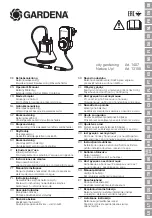
9
Using the HT-S Dielectric Withstand Tester
The dielectric withstand test involves high voltage and caution should be exercised when using the
tester. The return lead of the tester is connected to ground potential and when properly connected to the
equipment being tested, it will guard against the operator contacting high voltage. Always make sure the
return lead is firmly connected to exposed dead metal before start testing. To make sure if the connections
between the dielectric withstand tester and the equipment under test is correct, see the Testing section for
more detail. In the sections below, the three tests are explained.
Ground Continuity
The ground continuity test ensures that the grounding pin of the power supply cord is properly
connected to the exposed dead metal of the chassis. If this connection is absent, the exposed dead metal of
your product could be at line potential indefinitely after an internal wiring fault, causing risk of shock to
anyone touching it.
If the green
Ground OK
LED light is on, the connection between the grounding pin and the
exposed dead metal of the equipment being tested has a resistance lower than adjusted on the rear panel.
Ground Continuity Failures
If the red
Ground Open
LED light is on, the buzzer sounds, and the test is terminated. The
connection between the grounding pin and the exposed dead metal of the chassis has a resistance higher
than the indicated in the ground setting. This indicates a problem with the connection of the HT-S to the
equipment being tested, or that the ground connection in the equipment being tested is defective. The
connection to the tester should be checked by removing the Test Return Lead clip from the equipment
under test and reconnecting it, taking care to make a good connection. The unit should then be retested. If
a failing result is repeated, the connection between the power supply cord ground pin and the chassis of the
equipment being tested should be checked and reworked until a passing result is obtained.
Defeating the Ground Continuity
The ground continuity can only be conducted on equipment using a three wire grounded power
supply cord. Some equipment, such as most portable lamps and all double insulated tools, have only a two
wire power supply cord, so the Ground Continuity test cannot be conducted.
Please note that defeating the Ground Continuity should not be done except when necessary to test
two-wire devices. The Ground Continuity feature provides an extra level of operator safety because high
voltage will not be applied if the Test Return Lead is not properly connected to the exposed dead metal of
the equipment being tested. If the Test Return Lead is not properly connected, a dielectric withstand failure
may energize exposed dead metal. Additionally, the HT-S may not recognize the failure. The test will
continue for its normal length of time, and the HT-S may show a "PASS".
To allow the HT-S to test equipment using a two wire power supply cord, the Ground Continuity
test can be defeated by turning the rear panel Ground Check switch to the Off position. To remind the
operator that the Ground Continuity test is not being conducted, both the green
Ground OK
and red
Ground Open
LED's will be lit continuously during the test. When testing with the Ground Check switch
in the Off position, the operator must ensure that the Test Return Lead is properly connected to exposed
dead metal of the equipment being tested for safety and to ensure that the HT-S properly reports all failures.










































